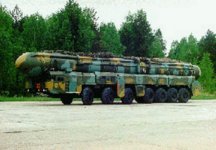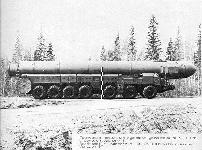 The
RT-2 is a road mobile 3-stage, single warhead ICBM. Its
29.5 meter length and 1.7meter diameter are approximately
the same size and shape as the U.S. Minuteman ICBM. It has
a throw-weight of 1000 kg and carries a single warhead
with a yield of 550 Kt and accuracy (CEP) of 900m
according to Russian sources [as opposed to 300m according
to Western sources]. Its road mobile capability gave the
SS-25 an extremely high rate of survivability. It can fire
from field deployment sites or through sliding roof garage
bases. The SS-25 joined operational Soviet SRF regiments
in 1985. A total area of approximately 190,000 square
kilometers could be required to deploy a force consisting
of 500 road-mobile SS-25 ICBMs. Mobile units require a
much higher number of personnel for maintenance and
operation than fixed systems. In turn, the SS-25 was
significantly more costly to maintain and operate than
silo launched systems. The
RT-2 is a road mobile 3-stage, single warhead ICBM. Its
29.5 meter length and 1.7meter diameter are approximately
the same size and shape as the U.S. Minuteman ICBM. It has
a throw-weight of 1000 kg and carries a single warhead
with a yield of 550 Kt and accuracy (CEP) of 900m
according to Russian sources [as opposed to 300m according
to Western sources]. Its road mobile capability gave the
SS-25 an extremely high rate of survivability. It can fire
from field deployment sites or through sliding roof garage
bases. The SS-25 joined operational Soviet SRF regiments
in 1985. A total area of approximately 190,000 square
kilometers could be required to deploy a force consisting
of 500 road-mobile SS-25 ICBMs. Mobile units require a
much higher number of personnel for maintenance and
operation than fixed systems. In turn, the SS-25 was
significantly more costly to maintain and operate than
silo launched systems.
The three stage solid propellant RT-2PM
Topol became the first Soviet mobile ICBM to be
successfully deployed. It was deployed after two decades
of unsuccessful attempts by different design bureaus to
create a reliable mobile launch system. It emerged from
the same line of development as mobile missiles such as
the SS-X-16 Temp-2S and the 'SS-20 Pioneer, and was
deployed as a replacement for the widely deployed SS-11
SEGO.
All three stages are made of composite
materials. First stage operation the flight control is
implemented through four aerodynamic and four jet vanes.
Four similar trellised aerodynamic surfaces serve for
stabilization. During the second and third stage of flight
gas is injected into the diverging part of the nozzle for
flight control.
The missile is deployed in a Transporter
Erector Launcher (TEL) canister mounted on cross-country
7-axle chassis on a mobile launch vehicle (see photo
below). The chassis incorporates jacks, gas and hydraulic
drives and cylinders, with a power of several hundred
tons, for jacking and leveling of the launcher, speeding
up (combat) and slowing down (maintaining) elevation of
the container with the missile in the vertical position.
The TEL is accompanied by a Mobile command post, carrying
support facilities mounted on cross-country 4-axle chassis
with unified vans. The complex is equipped with an onboard
inertial navigation system which gives the TEL group the
capability to conduct the launch independently from its
field deployment sites. This topo-geodesic support and
navigation subsystem, created by the "Signal" Research
Institute, provides a quick and highly precise tie-in of
the launcher in a field position and enables its crew to
carry out missile launches from any combat patrol route
point. The launch can also be carried out at regimental
bases from the aforementioned garrison garage.
 Development
of the RT-2PM was approved on July 19, 1977 and carried
out by the Moscow Institute of Thermal Technology headed
by A. D. Nadiradzye. Flight tests were conducted on the
Plesetsk test site from February through December 1985.
The main problem that had to be overcome during this
period was the development of battle management system.
After the first test series was successfully conducted in
April 1985, with the first regiment with Topol missiles
put on alert in July 1985. Throughout this time work
continued on improving the battle management system. The
first regiment of "Topol"-missiles employing a
modernized mobile command center (in area the of Irkutsk)
were put on alert on 27 May 1988. The test missile firings
were finally completed in December 1987. Development
of the RT-2PM was approved on July 19, 1977 and carried
out by the Moscow Institute of Thermal Technology headed
by A. D. Nadiradzye. Flight tests were conducted on the
Plesetsk test site from February through December 1985.
The main problem that had to be overcome during this
period was the development of battle management system.
After the first test series was successfully conducted in
April 1985, with the first regiment with Topol missiles
put on alert in July 1985. Throughout this time work
continued on improving the battle management system. The
first regiment of "Topol"-missiles employing a
modernized mobile command center (in area the of Irkutsk)
were put on alert on 27 May 1988. The test missile firings
were finally completed in December 1987.
At the time of the signing of the
Start-1 treaty in 1991 the Soviet Union had deployed some
288 Topol missiles. Deployment continued, and at the end
of 1996 a total of 360 Topol missiles were deployed.
The Topol missile was deployed at
previously developed deployment sites. After the
INF-Treaty was signed in 1987 several SS-20 Pioneer
deployment sites were adapted to launch the SS-25 Topol
missiles. The United States expressed specific concerns
during the INF treaty negotiations. When the SS-25 missile
system was deployed in the field, with its missile inside
the canister and mounted on the launcher, the US contended
that the canister might conceal an SS-20 missile. This was
of concern because unlike the sigle warhead of the SS-25,
the SS-20 carried up to 3 warheads. A resolution was
reached after the Soviet Union agreed to allow inspection
parties to use radiation detection systems to measure fast
neutron intensity flux emanating from the launch canister.
A launch canister with a missile inside containing a
single warhead (SS-25) emitted a different pattern of fast
neutrons than did one with a missile having three warheads
(SS-20).
Provisions of the SALT-2 agreement
prohibited the deployment of more than one new missile
(which became RT-23UTTh), it was officially declared by
the Soviet Union that the SS-25 Topol was developed to
upgrade the silo based SS-13 RT-2P. The US government
disputed this view, contending that the missile was
clearly more than 5% larger and had twice the throw-weight
as the SS-13 and therefore constituted a new misile
system.
An SS-25 with two MIRVs may have been
tested in 1991, and the missile was tested at least once
with four MIRV warheads, but there has apparently been no
further development of a multiple warhead version. This
became a point of contention during the conclusion of the
1991 START negotiations, at which time the US pressed for
a definition of "downloading" (removing warheads
from missiles) that would complicate any Soviet attempt
suddenly to deploy multiple warheads on the SS-25.
Russia plans to reequip approximately
400 silos where obsolete SS-11, SS-13 and SS-17 missiles
are located. Under the START-II Treaty Russia is permitted
to place 90 single- warhead solid fuel missiles in
reequipped SS-18 ICBM silos. In order to guard against a
break-out scenario involving the rapid reconversion of
SS-18 silos on-site inspection became a very important
aspect of Start II verification. In accordance with the
Protocol on Procedures Governing Elimination of Heavy
ICBMs and on Procedures Governing Conversion of Silo
Launchers of Heavy ICBMs, US inspectors could either
physically witness the pouring of the five meters of
concrete in the bottom of the silo or measure silo depth
before and after concrete was poured. The Treaty did
prohibit placing a launch canister greater than 2.5 meters
in diameter. The Russians have undertaken a concerted
political commitment to deploy only a single-warhead ICBMs
of the SS-25 type in these converted launchers. The
possibility exists, however that Russia could further
modify the converted SS-18 silos to enable them to launch
a different missile than the one declared.
The breakup of the Soviet Union had a
significant impact on the Topol program. The dispersed
manufacturing of ICBM components serious complicated
researching and building new missile systems For example
the Minsk Wheeled Truck-Tractor Manufacturing Plant [MAZ]
in Belarus manufactured the missiles' transporter
launchers, and some 90% of the components of the guidance
system were manufactured in Ukraine.
In Belarus, as of December 1995, 63
SS-25 ICBMs originally deployed there had been returned to
Russia. As of December 1995, Belarus had two operational
SS-25 mobile ICBM regiments remaining on its territory,
with a total of 18 nuclear warheads. In July 1992, Belarus
signed an agreement with Russia placing the regiments
under exclusive Russian control. In September 1993, Moscow
and Minsk signed an agreement requiring the return of
these nuclear missiles and all related missile support
equipment to Russia by the end of 1996. A total of 81
SS-25 ICBMs and associated warheads were returned to
Russia from Belarus.
By the late 1990s the lack of resources
and qualified personnel forced the Russian Navy to cut
back operations considerably, with no more than one or two
regiments of the mobile SS-25 missiles dispersed in the
field. The remaining 40 or so regiments, each with nine
single-warhead missiles, remain in garrison.
In February 2001, in a special test of
operational readiness, the Strategic Missile Forces
successfully launched a silo-based Topol ICBM at a target
in the Kura range in Kamchatka. The Topol missile, the
oldest of its type still in the Russian arsenal, was said
to have performed flawlessly despite having outlived by
150 percent its operational period of service.
|